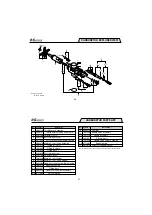
18
GLOWPLUG
The role of the glowplug
Glowplug life
Particularly in the case of very high performance
engines, glowplugs must be regarded as expendable
items. However, plug life can be extended and engine
performance maintained by careful use, i.e.:
Install a plug suitable for the engine.
Use fuel containing a moderate percentage of
nitromethane unless more is essential for racing events.
Do not run the engine too lean and do not leave the
battery connected while adjusting the needle.
With a glowplug engine, ignition is initiated by the
application of a 1.5-volt power source. When the
battery is disconnected, the heat retained within the
combustion chamber remains sufficient to keep the
plug filament glowing, thereby continuing to keep the
engine running. Ignition timing is 'automatic' : under
reduced load, allowing higher rpm, the plug becomes
hotter and, appropriately, fires the fuel/air charge
earlier; conversely, at reduced rpm, the plug become
cooler and ignition is retarded.
Apart from when actually burned out, a plug may
need to be replaced because it no longer delivers its
best performance, such as when:
When to replace the glowplug
Filament surface has roughened and turned white.
Filament coil has become distorted.
Foreign matter has adhered to filament or plug
body has corroded.
Engine tends to cut out when idling.
Starting qualities deteriorate.
Since the glowplug and fuel combination
used may have a marked effect on
performance and reliability, it would be
worthwhile to experiment with different
plug types. Recommended O.S. plugs are
No.8, No.7 and No.10 (Former A5) .
Carefully install plug finger-tight, before
final tightening with the correct size plug
wrench.
19
With a fixed-wing model, power failure is rarely a
serious threat to the safety of the aircraft since it can
usually glide down to a safe landing. In a helicopter,
on the other hand, it is vitally imporant that the engine
keeps running and that there is a quick and reliable
response to the throttle in order to ensure safe ascent
and descent of the model.
The High-Speed (Main) Needle Valve
When set to produce maximum power at full
throttle, this establishes the basic fuel/air mixture
strength. This is then maintained by the carburetor's
automatic mixture control system to cover the
engine's requirements at reduced throttle settings.
The Idle Mixture Control Screw
This provides the means of manually adjusting the
mixture control valve. By setting the Mixture Control
Screw for the best idling performance, the mixture
control valve automatically ensures that fuel is
accurately metered to maintain the correct mixture
strength as the throttle is opened.
Three adjustable mixture controls are incorporated in the
Type 40L. They are as follows.
A
B
The Medium Speed Needle Valve
This is an extra control that can be brought into
play, if necessary, after adjusting A and B above. It
provides the means of fine-tuning mixture strength
over that all-important part of a helicopter's throttle
range where the model is flying in, or near, the
hovering mode.
C
Idle MIxture Control Screw
High Speed Needle Valve
(Main Needle)
Medium Speed
Needle Valve
As the idle mixture control screw is installed with
LOCTITE, it may initialy feel stiff, and it is suggested
to use a slightly oversized screwdriver. The screw can
be turned only 90 degrees either way. Do not force to
turn further, or it may break or cause trouble.
NOTE
90 degrees
90 degrees
CARBURETOR CONTROLS









































